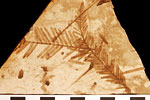Paleontology and geologyThe Precambrian: During the Precambrian, the area now occupied by Oregon was deep ocean, and no rocks from the Precambrian have been preserved anywhere in the state.
The Paleozoic: Throughout much of the early Paleozoic (Cambrian through Silurian) what is now Oregon was covered by the sea, and no rocks from these time intervals have been preserved anywhere in the state. During the middle and late Paleozoic (Devonian through Permian), tectonic activity resulted in a series of volcanic islands in the area that has become Oregon. Limestones containing fossils of corals, brachiopods, and other marine animals provide evidence of the coral reefs and lagoon environments that also formed at this time, and plant fossils indicate the presence of nearby terrestrial environments.
The Mesozoic: Shallow seas persisted over most of state through the Mesozoic. Oysters, corals, and snails were important members of the marine communities during this time interval. Vertebrates are represented by fossil fragments of pterosaurs and marine reptiles such as ichthyosaurs.
The Cenozoic: Fossils of turret and fig shells (snails) indicate that warm-water conditions persisted into the early Cenozoic (Tertiary) over part of Oregon. Conditions became cooler and drier by the middle Tertiary, and marine organisms similar to modern species inhabited the waters off the coast. Forests of oak and alder were common, and mammals such as horses, camels, deer, and cats, as well as extinct gomphotheres (early elephants) and bear-dogs wandered the landscape. The Coast Range and the Cascades began to rise as a result of tectonic activity during the Tertiary. Later in the Cenozoic (Pleistocene), large ice caps covered the mountainous regions of the state. Lowland and coastal regions were covered by a diversity of environments, including forests, savanna, and arid plains. The Cascade volcanoes continued to erupt periodically throughout the late Cenozoic. |

